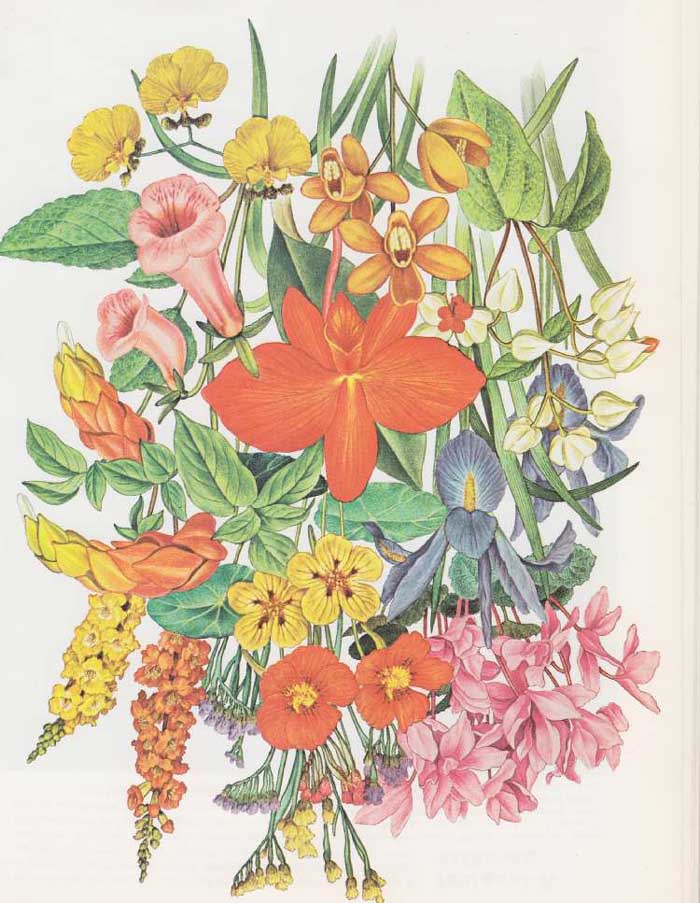CONTENTS
- 1. A year-round garden in a house of glass
- 2. A choice of plants, methods and
temperature
- Picture essay: THE SHAPES OF GREENHOUSES TO COME
- 3. Getting flowers the size you want
when you want
- Picture essay: THE AMATEUR’S EXOTIC FAVORITE -- ORCHIDS
- 4. The fine art of creating new plants
- Picture essay: OASES OF GREEN DESIGNED TO BE LIVED IN
- 5. An encyclopedia of plants for the greenhouse
Special sections on:
- Greenhouse pests and diseases
- Characteristics of over 100 greenhouse plants

It’s December, but your azaleas are in full flower, vibrantly crimson against the snow outside. Or it’s a special anniversary, birthday or wedding, and the long- stemmed roses you programmed for the occasion are in glorious bloom, exactly on schedule. These and other gardening triumphs — such as growing unusual or exotic plants a hemisphere removed from their native habitats, or making common American plants grow to uncommon splendor and perfection—can be yours with a home greenhouse. In this Guide, an eminent American horticulturist, introduces you to the exciting world of Ultimate Greenhouse Gardening.
As a greenhouse gardener, we point out, you become the absolute ruler of a small and beautiful plant kingdom. With light and warmth under your control, with soils precisely tailored and nutrients calculated to foster plant health, and with pruning skillfully executed, you can create almost any plant world you dream of. You can even go on to challenge the professionals at plant breeding, hybridizing your own varieties (and reaping the special reward of naming the new flower or shrub yourself).
Ultimate Greenhouse Gardening is a comprehensive guide, indispensable for the beginner, and an invaluable reference source for the experienced gardener as well. Lots of attention is devoted to a full-color illustrated encyclopedia of beautiful and unusual plants, from all parts of the world, that are suitable for greenhouse cultivation wherever you may live—together with clear, precise instructions on providing the growing conditions they will need. (There is also a special section on greenhouse pests and diseases.)
With this guide, you will learn about modern greenhouse construction, about energy- and labor-saving devices for temperature and ventilation control that are now available, and about the varying opportunities that “warm,” “cool” and “intermediate” greenhouses offer. Heating, lighting and shading your greenhouse; mixing and testing the soil; judging water needs; and finding microclimates within your green house are all explained. Hydroponics—for either flower or vegetable gardening—is likewise illustrated.
The nurserymen’s tricks to make a plant do what it would not do naturally—so that you, too, can get flowers of the size you want, when you want them—are revealed here. How to use artificial light and dark, or refrigerator cold, to reset a plant’s internal calendar. How to “pinch” and “disbud” to control the size, shape and profusion of blooms. How you can produce “standards”—those tall, slim plants with one straight stem topped by a large pouf of foliage or one spectacular blossom.
You will also. be introduced in these pages to the arts of propagation, the techniques of creating new plant varieties. Each year, thousands of Americans are producing uncountable assortments of irises, lilies, gloxinias, African violets, orchids, calceolarias and many others; nearly a thousand new day lilies alone are developed annually. The mechanics of hybridization are fairly simple, but patience and careful record-keeping are required. A greenhouse, and a proper understanding of its uses, will greatly increase your chances of success.
= = = =
Here is a sampling of the information on ULTIMATE GREENHOUSE GARDENING that you’ll find in this fact-filled volume:
Greenhouse varieties of plants, once offered only to commercial buyers, are becoming increasingly available to amateurs. These enable you to produce very large blossoms at a specific date Seeds for winter-blooming florists' carnations, for instance, are now available in 25 different colors.
A technique called misting has revolutionized the propagation of stem cuttings that once were very difficult to root, including azaleas, camellias, jasmine, roses and holly Misting speeds rooting because the cooled cuttings can be kept in direct sunlight without either cooking or drying out.
With "bottom heat" from thermostatically regulated soil-heating cables, cuttings will root in one third the usual time, and in a heated seed bed four to five times as many seeds will germinate as will in an unheated bed.
Be particularly vigilant in the fall when you are bringing plants into the greenhouse that have spent the summer outdoors, many pests will be hitching a ride into your pleasant winter resort.
Plants do most of their growing at night. That makes night temperatures critical. Plants exposed to summer-like night temperatures in the winter, and thus pushed to grow, are forced to draw on food reserves. The result can be weak, spindly plants and blooms that deteriorate rapidly. If you want plants to bloom out of season, you must give them dormancy out of season--at refrigerator temperatures, in some cases. Then bring them to the artificial warmth of the greenhouse. To the plants, winter has gone and spring has arrived, they respond accordingly.
Articles in this Guide are based on now-classic Time-Life Encyclopedia of Gardening Series from the 1970s ... a timeless series, some titles of which are still available in libraries and bookstores... see our Amazon Store for purchasing options.
Prev. (none) | Next